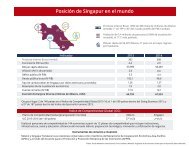basic-guide-to-exporting_Latest_eg_main_086196
basic-guide-to-exporting_Latest_eg_main_086196
basic-guide-to-exporting_Latest_eg_main_086196
You also want an ePaper? Increase the reach of your titles
YUMPU automatically turns print PDFs into web optimized ePapers that Google loves.
offers. The location or nationality of the website host does not typically affect accessibility of thesite; however, your company should ensure that the servers of the host under consideration residewithin a stable infrastructure and are <strong>main</strong>tained for optimal reliability.Localizing and Internationalizing Website ContentCompanies seeking foreign audiences with their websites will want <strong>to</strong> either localize orinternationalize their websites. They may also provide a mixture of both processes. Localizationconsists of adapting one’s website <strong>to</strong> meet the linguistic, cultural, and commercial requirementsof a targeted market. Internationalizing a website enables a company <strong>to</strong> be multilingual andsensitive <strong>to</strong> cultural conventions without the need for extensive redesign. Localization orinternationalization must be part of the online exporter’s corporate strat<strong>eg</strong>y for website andbusiness development. Features your company should consider include:• Language• Cultural nuances, such as differences incolor association and symbols• Payment preferences• Pricing in the appropriate currencyPromoting Your Website• Currency converter• Metric measurements• Information on duties and taxes assessedon your product by key country marketSetting up shop is no guarantee that cus<strong>to</strong>mers will come flooding in. If you want a successfulwebsite, you must not wait for people <strong>to</strong> stumble across it. There are a number of ways <strong>to</strong>promote your site without spending a lot of money:• Send brief s<strong>to</strong>ries about your company and website <strong>to</strong> trade publications that serve the largerindustry or business sec<strong>to</strong>r in your target market(s).• Put your web address on business cards, letterheads, envelopes, packaging, and promotionalmaterials of all kinds.• Ask foreign visi<strong>to</strong>rs if they’d like <strong>to</strong> receive occasional “opt-in” ads, which are essentiallye-mails promoting upcoming sales or new products. Encourage those visi<strong>to</strong>rs who consent<strong>to</strong> receiving the opt-in ads <strong>to</strong> e-mail them <strong>to</strong> a friend or relative. People who agree <strong>to</strong> receiveopt-in ads tend <strong>to</strong> purchase up <strong>to</strong> seven times as frequently as other visi<strong>to</strong>rs.• Consider sending people who visited or r<strong>eg</strong>istered on your website but did not buy anythinga follow-up e-mail with a coupon for a discount on your products and services.• Use social media <strong>to</strong> promote your website, products, and expertise.Executing Orders and Providing After-Sales ServiceGive your online orders similar treatment as your offline orders—be knowledgeable about the<strong>to</strong>pics discussed in earlier chapters, as well as payment modes and terms, shipping and pricing,cus<strong>to</strong>mer service, and taxation.Payment Modes and TermsCompanies that use the Internet <strong>to</strong> reach overseas cus<strong>to</strong>mers frequently use their website <strong>to</strong>process orders and accept payments. Since payment practices vary from country <strong>to</strong> country, it isChapter 11: Going Online—E-Exporting Tools for Small Businesses127





